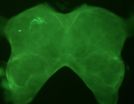(Press-News.org) Scientists have identified an ingeniously elegant brain circuit consisting of just five nerve cells that allows female crickets to automatically identify the chirps of males from the same species through the rhythmic pulses hidden within the mating call.
The circuit uses a time delay mechanism to match the gaps between pulses in a species-specific chirp - gaps of just few milliseconds. The circuit delays a pulse by the exact between-pulse gap, so that, if it coincides with the next pulse coming in, the same species signal is confirmed.
It's one of the first times a brain circuit consisting of individual neurons that identifies an acoustic rhythm has been characterised. The results are reported today (11 September) in the journal Science Advances.
Using tiny electrodes, scientists from Cambridge University's Department of Zoology explored the brain of female crickets for individual auditory neurons responding to digitally-manipulated cricket chirps (even a relatively simple organism such as a cricket still has a brain containing up to a million neurons).
Once located, the nerve cells were stained with fluorescent dye. By monitoring how each neuron responded to the sound pulses of the cricket chirps, scientists were able to work out the sequence the neurons fired in, enabling them to unpick the time delay logic of the circuit.
Sound processing starts in hearing organs, but the temporal, rhythmic features of sound signals - vital to all acoustic communication from birdsong to spoken language - are processed in the central auditory system of the brain.
Scientists say that the simple, time-coded neural network discovered in the brain of crickets may be an example of fundamental neural circuitry that identifies sound rhythms and patterns, and could be the basis for "complex and elaborate neuronal systems" in vertebrates.
"Compared to our complex language, crickets only have a few songs which they have to recognise and process, so, by looking at their much simpler brain, we aim to understand how neurons process sound signals," said senior author Dr Berthold Hedwig.
Like in Morse code, contained within each cricket chirp are several pulses, interspersed by gaps of a few milliseconds. It's the varying length of the gaps between pulses that is each species' unique rhythm.
It is this 'Morse code' that gets read by the five-neuron circuit in the female brain.
Crickets' ears are located on their front legs. On hearing a sound like a chirp, nerve cells respond and carry the information to the thoracic segment, and on to the brain.
Once there, the auditory circuit splits and sends the information into two branches:
One branch (consisting of two neurons) acts as a delay line, holding up the processing of the signal by the same amount of time as the interval between pulses - a mechanism specific to a cricket species' chirp. The other branch sends the signal straight through to a 'coincidence detector' neuron.
When a second pulse comes in, it too is split, and part of the signal goes straight through to the coincidence detector. If the second pulse and the delayed signal from the first pulse 'coincide' within the detector neuron, then the circuit has a match for the pulse time-code within the chirp of their species, and a final output neuron fires up, when the female listens to the correct sound pattern.
"Once the circuit has a second pulse, it can define the rhythm. The first pulse is initial excitation; the second pulse is then superimposed with the delayed part of the first. The output neuron only produces a strong response if the pulses collide at the coincidence detector, meaning the timing is locked in, and the mating call is a species match," said Hedwig.
"With hindsight, I would say it's impossible to make the circuitry any simpler - it's the minimum number of elements that are required to do the processing. That's the beauty of nature, it comes up with the most simple and elegant ways of dealing with and processing information," he said.
To find the most effective sound pattern, the scientists digitally manipulated the natural pulse patterns and played the various patterns to female crickets mounted atop a trackball inside an acoustic chamber containing precisely located speakers.
If a particular rhythm of pulses triggered the female to set off in the direction of that speaker, the trackball recorded reaction times and direction.
Once they had honed the pulse patterns, the team played them to female crickets in modified mini-chambers with opened-up heads and brains exposed for the experiments.
Microelectrodes allowed them to record the key auditory neurons ("it takes a couple of hours to find the right neuron in a cricket brain"), tag and dye them, and piece together the neural circuitry that reads rhythmic pulses occurring at intervals of few milliseconds in male cricket chirps.
Added Hedwig: "Through this series of experiments we have identified a delay mechanism within a neuronal circuit for auditory processing - something that was first hypothesised over 25 years ago. This time delay circuitry could be quite fundamental as an example for other types of neuronal processing in other, perhaps much larger, brains as well."
INFORMATION:
The research was funded by the Biotechnology and Biological Sciences Research Council (BBSRC).
Researchers from Lund University in Sweden have shown that well-developed eyes come at a surprising cost to other organ systems. The study involving Mexican cavefish shows that the visual system can require between 5% and 15% of an animal's total energy budget.
Researchers have long associated the presence of a well-developed brain with major energy consumption. This means that animals that develop advanced nervous systems require environments where this is possible. There has to be good access to nutrients, and every investment in an organ comes at a cost to some other ...
WASHINGTON (Sept. 11, 2015) - A statement from American College of Cardiology President Kim Allan Williams Sr., M.D., FACC, regarding the National Institutes of Health stopping the SPRINT trial early after demonstrating the positive benefits of lower blood pressure control targets:
"About 70 million American adults have high blood pressure and only half of them have their condition under control. The preliminary data demonstrates why the cardiovascular community must continue to aggressively fight a condition that leads to stroke, kidney disease and heart problems for ...
Washington, DC - September 11, 2015 - Periodontitis is a risk factor for heart disease. Now a team of researchers has shown that a periodontal pathogen causes changes in gene expression that boost inflammation and atherosclerosis in aortic smooth muscle cells. The research is published ahead of print in Infection and Immunity, a journal of the American Society for Microbiology.
The circumstantial evidence that led to this study was ample. The periodontal pathogen, Porphyromonas gingivalis, has also been found in coronary artery plaques of heart attack patients. And in ...
This election year has produced 17 Republican presidential candidates, which on its surface may appear to give the party a competitive advantage. Evolution, however, disagrees.
A new study by Michigan State University researcher Arend Hintze and appearing in the current issue of Scientific Reports, says the delicate balance of some, but not too much, competition optimally drives the evolution of decision-making strategies.
"Competition has a unique relationship with our decision-making strategies as humans," said Hintze, an assistant professor at MSU. "Modest competition ...
An overview of regulatory solutions worldwide on the use of nanotechnology in food and feed production shows a differing approach: only the EU and Switzerland have nano-specific provisions incorporated in existing legislation, whereas other countries count on non-legally binding guidance and standards for industry. Collaboration among countries across the globe is required to share information and ensure protection for people and the environment, according to a JRC co-authored paper.
The paper Regulatory aspects of nanotechnology in the agri/feed/food sector in EU and ...
The list of potential mechanisms that underlie an unusual metal-insulator transition has been narrowed by a team of scientists using a combination of X-ray techniques. This transition has ramifications for material design for electronics and sensors.
The transition between being electrically conductive (metallic) at high temperatures and electrically insulating at lower temperatures is known as a metal-insulator transition (MIT). Pinpointing the activation mechanism that allows crystals used in devices such as transistors in electronics and temperature-based sensor control ...
The light that typically floods homes, offices and public buildings could provide something more than illumination. Scientists at Disney Research and ETH Zurich have demonstrated that light could be a medium for light bulbs to communicate - with each other, with objects and with the Internet.
Transmitting signals via light is nothing new; Alexander Graham Bell showed that speech could be conveyed with light in the 1880s, years before speech was first transmitted via radio. The Disney researchers, however, have created networking technology that makes it possible for LED ...
KANSAS CITY, MO -- Cellular mitosis depends in part on small organelles that extend spindles to pull apart chromosome pairs. Before they can perform this and other essential tasks, these tiny cylindrical structures -- known as centrioles in animals and spindle pole bodies (SPBs) in yeast -- must themselves duplicate.
However, much about this nanoscale process has remained veiled by the limits of current microscopy. Optical approaches cannot resolve objects below certain wavelength limits, while non-optical approaches like electron microscopy (EM) can only study nonliving ...
What if tornado activity could be forecasted months, even seasons in advance? Thanks to a new model developed at the University of Toronto Scarborough, that ability could soon become a reality.
"The aim is to predict ahead to the following year or subsequent years about whether we'll get above or below average tornado activity in a given area," says Vincent Cheng, a postdoctoral fellow in UTSC's Ecological Modelling Lab.
The model, developed by Cheng, Professor George Arhonditsis and Professor Bill Gough in UTSC's Climate Lab along with colleagues at Environment Canada, ...
Genetic mutations called "escape variants" in the deadly Ebola virus appear to block the ability of antibody-based treatments to ward off infection, according to a team of U.S. Army scientists and collaborators. Their findings, published online this week in the journal Cell Reports, have implications for the continued development of therapeutics to treat Ebola virus disease, which has claimed the lives of over 11,000 people in West Africa since last year.
Ebola virus overruns the immune system, thus overwhelming the host's ability to fight off the infection. One strategy ...


